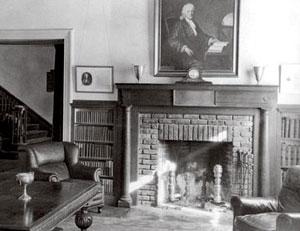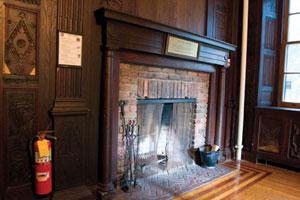  |
By Emily Gold Boutilier
As the creator of a web site called askphilosophers.org, Alexander George is accustomed to a steady diet of odd queries. So when a student asked him whether it’s true that Sir Isaac Newton’s fireplace is inside a dorm on campus, the professor of philosophy wasn’t fazed. “Of course it’s not true,” he replied. “How could that be?”
But to double-check, George contacted Archives and Special Collections at Amherst. He was taken aback to learn that Plimpton dorm—formerly Delta Kappa Epsilon house—is indeed home to a fireplace made of bricks and wood from 35 St. Martin Street in London, where Newton lived from 1710 until his death in 1727.
How did the fireplace get to Amherst? George A. Plimpton, Class of 1876 and chairman of the Amherst board of trustees, purchased the bricks and wood when Newton’s house was demolished. The materials were made into a fireplace in order that DKE brothers “may catch Newton’s spirit,” as Plimpton told the Springfield Republican in 1915, when DKE house was dedicated.
At first, the room in DKE was a place for smoking and dancing. In addition to the fireplace, it featured a portrait of Newton and memorabilia relating to him. In 1936, the room was remodeled into the DKE library. Plimpton purchased wood paneling for the library from buildings in Oxford, England, including the house once occupied by Lord (Frederick) North, the British prime minister under King George III.
But there’s more to the story. Late in the 18th century, music historian Charles Burney lived at 35 St. Martin Street and hosted a famously awkward party there. Virginia Woolf wrote about the gathering in “Dr. Burney’s Evening Party”—a story in which the fireplace plays an important role. As the tale goes, one party guest, the aristocrat Fulke Greville, planted himself upon the hearth that night, waiting for another guest, the great author Samuel Johnson, to make the first conversational move. But Johnson kept his mouth shut. The party a bore, every guest waiting for someone else to talk first, Johnson at last directed his attention to Greville at the fireplace, declaring, “If it were not for depriving the ladies of the fire, I should like to stand upon the hearth myself!”
The Newton room in Plimpton now functions as a lounge and has recently become home to a ping-pong table. Located to the left of the soda and juice machines, the room also contains such artifacts as a 1965 chemistry textbook, priced at a mere $4.50, and a 1960s booklet, “Working with a slide rule.” The wood panels remain, but the portrait and memorabilia are long gone. A sign on the wall explains what to do in case of a chimney fire, and a small plaque on the mantle makes note of the room’s history.
Top photo courtesy of Archives and Special Collections; bottom photo by Jessica Mestre '10.